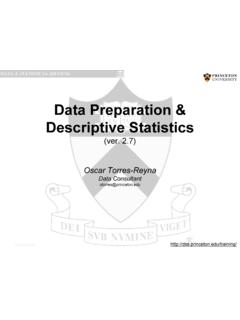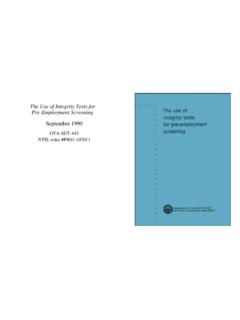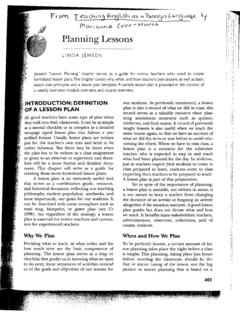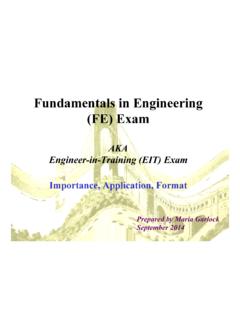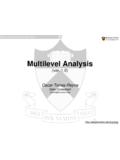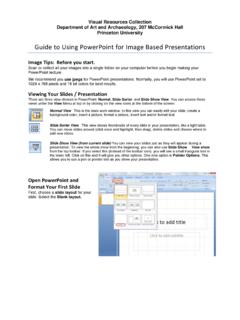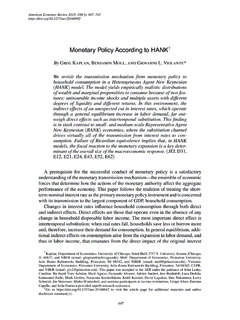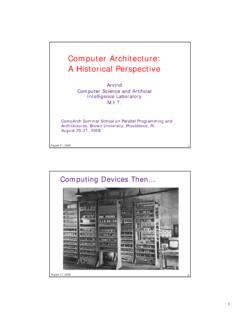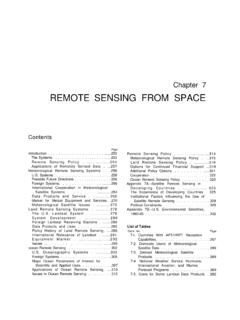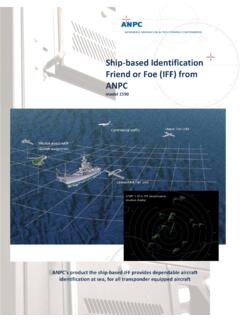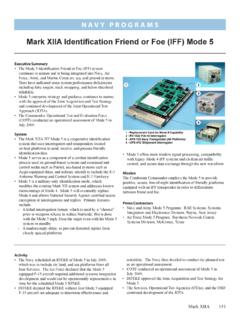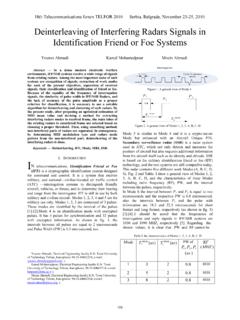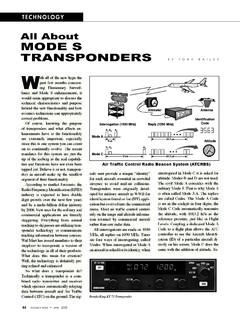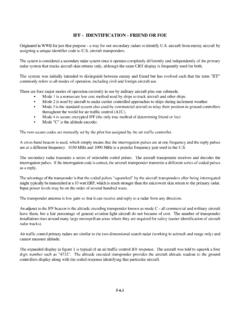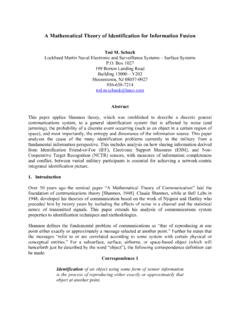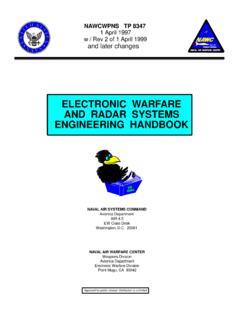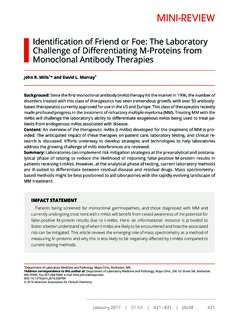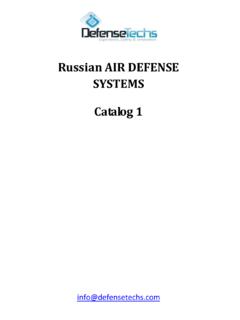Transcription of Who Goes There: Friend or Foe? (Part 8 of 8)
1 Absolute position, 35 Accidental self-destruction, 8 Accidents, fratricide due to, 9-10 Active systems, 39-40. See also Cooperative question-and-answer systems; Noncooperative question-and-answersystemsAir targets, avoiding fratricide of, 49-66 Aircraft identification , history, 54-55 Allied operations, 4, 29encryption keys and, 44 Amicicide, 8 Antifratricide systemscriteria, 45-46cross-Service coordination, 6doctrine, 47emergence, 2short-term and Iong-term goals, 5-6tactical environment awareness vs. IFF, 46training and simulation, 46-47 Army Training and Doctrine Command (TRADOC)antifratricide measures, 46fratricide definition, 9 ARSA-4 system, 65 Attack sequence, 32-33 Avoiding fratricide. See also Antifratricide systemsin air, 49-66general considerations, 29-48on ground, 69-79at sea, 66-67 AWACS, 50 Battle management, 33,49-50 Beacons, 73-75 Black boxes, 46 Bradley, Gen.
2 Omar, 13, 15 Bryan, C. D. B., 8 Budd Lights, 73-75,77,78 IndexCALL. See Center for Army Lessons LearnedCallaham, Lt. Commander, 20 Casualty report forms, 8 Casualty surveys. See Combat casualty surveysCauses of fratricidefindings, 3historical review, 7-28 Center for Army Lessons Learned (CALL), 19, 25-26 CID. See Combat IdentificationCivil airborne transponders, 62-63 Mode S systems, 63-65 Civil-military coordination, 62-66 Classification, attack sequence step, 32 Combat casualty surveys, 1,21-23data, 23 Combat identification (CID), 33 Command and control failures, 10-15, 28 Commercial carriers, Mode S system and, 64 Communicationin battle management, 49-50in tactical environment, 34, 71, 79 Communication failures, 28 Commuter carriers, Mode S system and, 64 Congressional issues, 5-6 Contests of less than national survival, considerations, 1,31 Cooperative question-and-answer systemsadvantages and disadvantages, 42aircraft identification and, 56-57limitations, 59-62passive cooperative IFF measures, 59passive measures, 59queries, 75replies, 75-76 Coordination failures, 28 Cross-Service coordination, 4,681.
3 82 I Who Goes There: Friend or Foe?DARPA Lights, 73-75,78 Decision to attack, attack sequence step, 33 Definition of fratricide, 9 Denial, 43,61 Detection, attack sequence step, 32 Direct system of information, 39 Dismounted infantry IFF programs, 76-77 Doctrine, 33,47, 79 Doppler radar, 59,77 Dye-loaded shells, ordnance identification , 21 Eisenhower, Gen. Dwight D., 14 Electromagnetic spectrum, 40,41 Encryption. See Information securityEngagement ranges, 30,37 Equipment design, 10 Europe, Mode S system and, 63 Examplesaccidents, 9-10 Civil War, 17-18command and control failures, 10-15fear of fratricide effects, 19-20fire discipline failures, 15-16identification failures, 17-18navigation failures, 16-17 World War II, 12-15 Explicit rules of engagement, 37-38 Exploitation, spoofing, and denial, 43,60-61 FAA.
4 See Federal Aviation AgencyFatalities. See LossesFear of fratricide, tactical constraints due to, 18-20,Federal Aviation Agency (FAA), joint military ATCoperations, 65-66 FEZs. See Fighter Engagement ZonesFighter Engagement Zones (FEZs), 53 Findings, 2-5 Fire discipline failures, 15-16,28 Force ratio, 30 Fratricide Incident Report, 46 Free-fire zones, 12 Frequency allocation, 65-66 Frequency trends, 30-31 Friendly Fire, 8Ft. Bliss, Texas, testing, 78 General aviation, Mode S system and, 64 General Officers Steering Committee, 6 Global position receivers, 78 Goto, Adm., 19 Ground targets, avoiding fratricide of, 69-79 Guderian, Gen., 15 High-resolution radars (HRR), 51-53 Historical review of causescombat casualty surveys, 1, 21-23general considerations, 7-9 Persian Gulf War, 7-8,26-28prevalence of fratricide, 20-22 Summary, 26-28tactical constraints due to fear of fratricide, 18-20,30training center data, 24-26types of fratricide, 9-18 Hooker, Gen.
5 Joseph, 17 Hopkins, Dr. James, 21 HRR. See High-resolution radarsHuman error, accidents due to, 10 Identificationcommand and control failures and, 11-12findings, 4improved, 30 identification failuresexamples, 17-18, 37types, 35-36 identification of Friend and Foe (IFF), 33advantages and disadvantages of systems, 42-43exchange of location information, 72exploitation, spoofing, and denial, 60-61frequency allocation and, 66information security, 43-45and knowledge of tactical environment, 34-35 Next Generation IFF, 59-62range and, 38rules of engagement, 35-38sources of information, 39-40system jamming, 61 identification systems, 67-68,72-73 IFF. See identification of Friend and Foe30 Implicit rules of engagement, 38 Indirect fire weapons, 22 Indirect system of information, 39 Infantry, 75-76 Information security, 43-45frequency bands and, 62 Mode 4, 57-59 Mode S and peacetime intelligence loss, 65question-and-answer systems, 75-76 Interrogators and transponderscivil airborne transponders, 62-65 Mark X protocol, 56-57 Mark XII protocol, 56-62,66-67 Mark XV protocol, 56-62 TACIT, 60 Jackson, Gen.
6 Thomas Stonewall, 17-18 JADO. See Joint Air Defense OperationsJamming, IFF and, 61-62 Jet engine modulation, 51 JEZs. See Joint Engagement ZonesJoint Air Defense Operations (JADO), 53,56 Joint Engagement Zones (JEZs), 53,56 Jungle fighting, 16-17 Knowledge of tactical environment, 33,34-35,46-47,70-72,79. See also Communication; NavigationIndex I83L-band system, 56,62 Land targets, avoiding fratricide of, 69-79 Lessons learned. See Center for Army Lessons LearnedLocation information exchange, 72 Long-range weapons, 22 IFF and, 38 Lossescomparison of numbers, 31fraction of deaths due to fratricide, 1,2, 31 Malfunctions, 9-10 Mark X protocol, 56-57 Mark XII protocol, 56-59limitations, 59-62onboard ships, 66-67 Mark XV protocol, 56-59improvements, 59-62 McNair, Lt. Gen. Leslie, 14 Medical records, 21 Mercer, Lt.
7 Col. George, 7,8 MEZs. See Missile Engagement ZonesMid-air collision prevention, 65 MILES. See Multiple Integrated Laser Engagement System Misadventure, 8 Misidentification, 18, 28 Missile Engagement Zones (MEZs), 53 Mitchell, Gen. William Billy, 11 Mock combat. See Training and simulationMode S systems, 63-65 Multiple Integrated Laser Engagement System (MILES),24-25 National Training Center (NTC), 9,24-26simulations, 46 Navigation, in tactical environment, 34-35,70-71,79 Navigation failures, 16-17,28 Next Generation IFF (NGIFF), 59-62No-fire zones, 12 Noncooperative systemsadvantages and disadvantages, 42-43, 44future of, 50ground targets and, 77-78radar, 51-53radio--emission intercept, 50-51surface-to-air missiles, 53, 56 NTC. See National Training CenterObserver/target energy transmission routes, 39-40.
8 See alsoCooperative question-and-answer systems; Noncoopera-tivequestion-and-answer systemsOccurrence patterns, 8-28 Operation COBRA, 12-14 Operation Desert Storm. See Persian Gulf WarOperation QUEEN, 14 Operation TOTALIZE, 14-15 Opposing forces, mock combat, 24-26 Ordnance identification , 21, 30-31 Passive systems, 39-40. See also Cooperative question-and-answer systems; Noncooperative systemsPatriot missile, 53,56 Persian Gulf Warequipment, 70fratricide during, 1,2,7-8,26-28,69friendly fire incidents, 1991, 27 Positive identification , 38 Prevalence of fratricide, 20-22 Psychological effects, 1-2, 31-32 Pyle, Ernie, 13 Radar, 51-53 Radio-emission intercept, 50-51 Record keeping, 8 Remotely Monitored Battlefield Sensor System (REM-BASS), 78 Resource allocation, 5 Rules of engagement, 5, 33, 35-38S-band system, 62Sa adah, Dr.
9 David, 21, 22 SARTIS. See Shipboard Advanced Radar Target Identifica-tion SystemSchrader, Lt. Col. Charles, 8,22 Scott, Adm., 19 Sea targets, avoiding fratricide of, 66-67 Selective identification Feature (SIF), 57 Sensor networks, 71 Sensor systems, 77-78 Severity, measuring, 31-32 Shipboard Advanced Radar Target identification System(SARTIS), 56 Ships, identification , 66-67 Short-range weapons, IFF and, 38 Short-term versus long term goals, 5-6 SIF. See Selective identification FeatureSimulations. See Training and simulationSingle Channel Ground and Airborne Radio System(SINCGARS), 71 Situational awareness. See Knowledge of tactical environ-mentSmall Lightweight Global Positioning Receivers (SLGRs),78 Sources of identification information. See identification ofFriend and Foe; Knowledge of tactical environmentSpoofing, 43,60 Submarines, identification , 66-67 Surface-to-air missiles, noncooperative IFF and, 53,56 TACIT See Time Authenticated CryptographicInterrogator/TransponderTac tical constraints due to fear of fratricide, 18-20 Tactical environment.
10 See Knowledge of tactical environ-mentTCAS. See Traffic Alert and Collision Avoidance SystemTechnical developmentsbeacons, 73-7584 I Who Goes There: Friend or Foe?findings, 4infantry identification , 77information security, 43-44resource allocation for, 5review, 78weapon and ordnance improvements, 30-31 Tempo of battle, 30 Thermal identification Device (TID), 73-75,78 Time Authenticated Cryptographic Interrogator/Transpon-der (TACIT), 60 TRADOC. See Army Training and Doctrine CommandTraffic Alert and Collision Avoidance System (TCAS),65-66 Training and simulation, 4-5antifratricide systems, 46-47 NTC mock combat, 24-26review, 79 Transponders. See Interrogators and transpondersTypes of fratricide, 9-18 Washington, Col. George, 7,8 WDMET. See Wound Data and Munitions EffectivenessWeaponsaim and ordnance delivery, 33misidentification due to similarities between, 18range, 30, 38types causing injury, 22 Wound Data and Munitions Effectiveness (WDMET), 22
